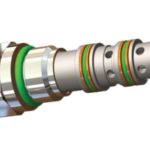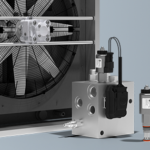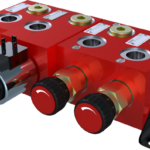By Josh Cosford, Contributing Editor Cartridge valves are a type of compact hydraulic valve that slips or screws into the machined cavity of a ported manifold or block. Unlike other valves, such as monoblock lever valves or stackable industrial valves, the manufacturer leaves the porting for you to decide. Cartridge valves still use poppets or […]
Valves / Manifolds
Electrohydraulic inverse proportional pressure relief valve for fan drives
The RPEI electrohydraulic inverse proportional pressure relief valve is a new high-capacity pressure control that provides smooth, precise speed control in fan drive applications. Designed for use in fan drive applications, the RPEI combines attributes of an electro-proportional adjustable pilot stage valve and a high-capacity main stage valve to provide precise pressure control inversely proportional […]
What are the differences between proportional and servovalves?
By Josh Cosford, Contributing Editor The line that separates the performance of servo and proportional valves has blurred in recent years. Some may consider a servovalve to be any valve capable of accurately positioning your actuator with closed-loop control. However, in everyday hydraulic circles, many industry professionals describe a servovalve as a valve with a […]
Electronic control units for hydraulic valve control
Argo-Hytos is launching new sophisticated and versatile proportional electronic control units for hydraulic applications. The EL7 control unit offers multiple types of analog input signals (nine) and also gives the user the option to switch to the CAN bus interface. Everything is easily parametrizable via Bluetooth using the ARGO-HYTOS app, which is free to download […]
HRV-HP inline pressure relief hydraulic valve
Doering’s hydraulic inline pressure relief valves are an easy way to protect any hydraulic system from pressure spikes. Easy to install and durable for a long life. HRV-HRVF-HRVM High Pressure direct-acting relief valves are normally closed, pressure-limiting valves used to protect hydraulic systems from pressure spikes. When the pressure at the inlet reaches the pressure […]
LunchBox Sessions and FPW take to YouTube Live again
Last year, Fluid Power World partnered with the experts at Lunchbox Sessions to promote special, free YouTube Live training sessions to bring accessible fluid power training to the world during lockdown. And although many people are back at work, there is always a need for quality education on hydraulic systems, so we are continuing this […]
Hydraulic and pneumatic Colorflow valves adapt to digital age
Contributed by Mike Giammo, product sales manager, and Mitch Eichler, business development manager, Parker’s Hydraulic Valve Div. Parker Colorflow valves have been a global standard in industrial and mobile applications for more than 60 years. The exclusive colored rings found on metering, flow control and needle valves provide users highly visible checkpoints that allow for […]
Double selector six-way hydraulic valves provide flow direction to two circuits
The DS-Double Selector hydraulic valve from Doering is a two position, six-way, double selector valve which directs the flow of hydraulic fluid to two separate hydraulic circuits within your hydraulic system. This flow divider valve allows the operation of two double-acting cylinders with one four-way control valve or four single-acting cylinders with two-three-way control valves. It […]
Proportional flow control valves for every application
In hydraulic systems, proportional flow control valves ensure that flow rates remain virtually constant. In doing so, they have to meet a large number of performance criteria that extend beyond their core function. According to engineers at Bucher Hydraulics, manufacturers and operators of mobile machines are increasingly placing a special emphasis on energy efficiency. Flow […]
Bosch Rexroth launches new Pre-Compensated Valve Platform for mobile machines
Flexible and adaptable, the Pre-Compensated Valve Platform makes it easier for mobile machine builders to selectively combine a range of hydraulic control valves into a single, integrated, multifunctional control solution to match specific operational and performance requirements. With the Pre-Compensated Valve Platform, Bosch Rexroth has engineered a solution that combines multiple valves with minimal need […]











